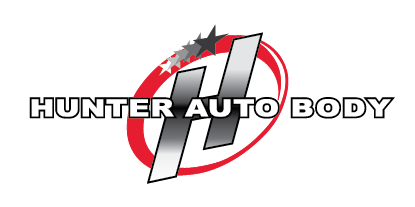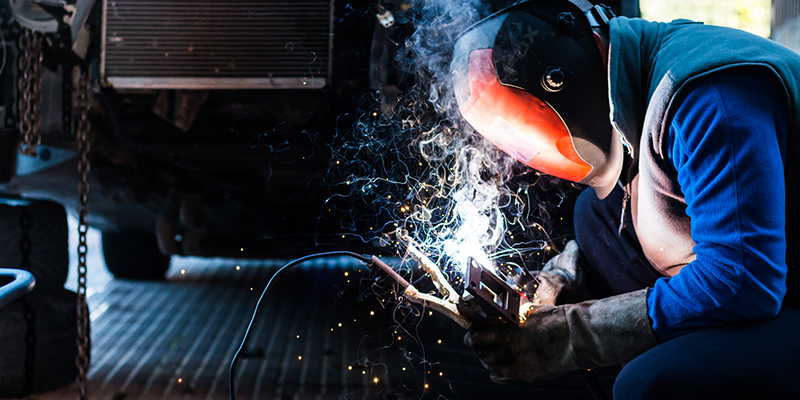If you are in need of collision repair, chances are that your car is going to require welding. Welding can be tricky business since different metals will react differently to heat. Many of our vehicles are being made with new types of metal and oftentimes, multiple types of metals.
Here is a frightening fact: Not all shops know how to weld correctly, and that could put your safety at risk.
The reason for some shops not knowing how to weld properly is because they rely simply on their years of experience and stick to what they know. The problem with relying on on experience is every year, new car models are being produced with new and improved frameworks, safety technology and metals to protect you as the driver. This is the problem facing collision repair technicians today if their management does not support taking the time to research and build an individual repair plan for every single repair.

There is a lot of chatter today in the collision repair industry about getting back to the basics of welding. Manufacturers are building cars with specific instructions on how and where to cut weld their vehicles, which is why following the repair procedures is so important. In some instances, these instructions go against the methods used even just last year. Some of the OEM instructions are also counter-intuitive. They might instruct technicians to weld directly over an existing weld. In the recent past, you would never think of doing a weld that way, and if you don’t take the time to study the procedure for that specific year make and model car, you have a very high chance of guessing wrong. The result could be fatal.
The best body shops in the world pride themselves on putting your car back together exactly the way it looked when it left the showroom. A skilled technician can repair your vehicle so well that it would be undetectable that the car was ever damaged or repaired. Oftentimes, these shops will look up and follow the manufacturer guidelines as well as perform a destructive weld test. This has been a point of pride for over 100 years in the trade. There are even Facebook groups filled with posts of poorly repaired cars. You will often see a photo of a noticeable repair (usually a bad color match as the giveaway) with the tagline “OK, who done it?”

The Difference In Original Factory Welds To Welding During The Repair:
We want to let St. Louis drivers know the importance of a body shop knowing where the manufacturer instructs weld repairs. For example, any technician would know to reinstall and tighten the removed bolts during the repair with the same level of strength as before. But that doesn’t necessarily mean that’s the only thing that needs to be done in the repair process. This is where the importance of following OEM repairs comes in. There may be changes from when the car was first manufactured and the current repair procedures that a technician needs to follow based on the current condition of the vehicle.
Now the manufacturers have started telling shops to stop thinking like that, which is upsetting the status quo in collision repair.
And why is this?
The materials used in new car construction are designed to save your life. As a result, they sacrifice themselves while transferring crash energy away from the occupants. Throughout the repair process, these pieces must be cut out and new ones put in, but here is the problem: body shops are not manufacturers, and they do not have tooling or machinery to stamp in new parts. In several of these materials, they can’t even be welded back in because they are sensitive to heat.
Take Audi, for example. Audi’s collision instructor and curriculum designer Shawn Hart stated an Audi “…factory has a much larger power level and uses ‘enormous’ weld heads compared to an aftermarket auto body shop. The collision repair industry has an option that duplicates the process well, but can’t match it 100 percent.”

Some structural parts and frame rails have to be glued back in, some have to be riveted back in, and some need to be glued and riveted or glued and welded. To the craftsman, performing a repair that would be visually noticeable is unheard of, and they might ignore the directives set forth by the manufacturer. This is not to say that the repairs will be noticeable to you on the outside of a vehicle, it just means that a proper repair might contain rivets on a frame rail that weren’t there when you purchased it. It may also mean that the spot welds are more massive, or there are more of them now than when the car was built. Not a big deal to you, but it’s a big deal that your technician is aware of these OEM procedures and that they follow them even if it means doing things differently for the first time in forty years.
OEM Repairs Are The Only Way To Go
The problem to the consumer is, and always will be (at least as of the time of this writing), no laws are forcing your shop or your technician to look up a manufacturer recommended procedure. Let alone, following these repair procedures. That’s right: you can buy unsafe repairs, and nobody and no law can stop that from happening.
This is why consumer education in collision repair is paramount today. And protecting yourself is as simple as having a conversation with your shop before they do anything. All you have to ask is to see the procedure page for your repair. Then, ask the shop to walk you through the work performed to your car. These OEM procedure pages, or “P-Pages,” can be printed out and handed to you. Before you accept the vehicle after the repair, ask your customer service rep to show you where they followed those procedures. If you are not satisfied, refuse to take delivery of the vehicle and call your insurance company.
Who In St. Louis Knows Where The Manufacturer Wants Them To Weld?
Luckily, if you are a customer of ours here at Hunter Auto Body, we always consult the OEM repair procedures before we begin any repair and never “wing it” based on whatever problems we can only see. Your safety is our number one priority, which is why we create a unique repair plan for every vehicle that comes into our shop.
We are proud to serve the St. Louis area and feel we can provide you with the best possible service for your automobile repair needs.
If you’d like to schedule a free estimate or wish to get a free online quote, click any of the buttons below to get started! We look forward to hearing from you and showing you why Hunter Auto Body is St. Louis’ number one choice in car repair!




